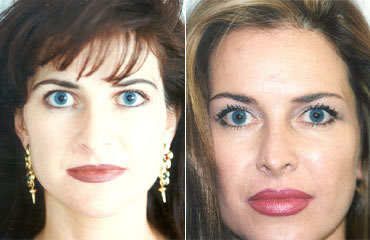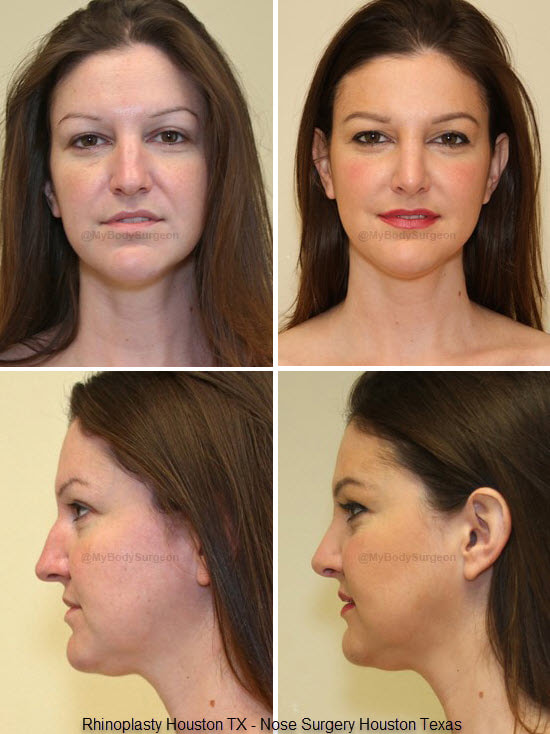
Rhinoplasty, also known as a nose job, is basically a plastic surgery technique for changing and reconstructing the nose for aesthetic purposes. There are basically two forms of plastic surgeries used in rhinoplasty reconstructive surgery which restores the shape and functions of the nose to an extent and/or cosmetic surgery which alters the appearance of the nose. In rhinoplasty, both the medial and the nasal sides are worked upon. In this process, all components of the nose are reshaped or changed in some way.
In a nose job procedure, the plastic surgeons make an incision starting from the ear extending to the base of the nose. The incision is widened to give a better view of the region where the procedure will be carried out and additional incisions made to insert any required artificial tissues or skin into the nostrils. After the nasal bones, cartilage, skin and soft tissues are removed through the nasal reduction, the muscles are tightened to restore normal functioning of the nose without making any noticeable difference with the other external features. The incision is closed with stitches and the nose job is done. Rhinoplasty can be done on younger patients who have not yet acquired wrinkling, drooping and sagging of the skin around the nose, but who still have good health according to the physician. Plastic surgeons perform the operation for teenagers and for those who are in good health. The recovery period is usually very short and the patient can go home the same day of the surgery. The nasal tipopharyngeal valve, or the natural breathing conduit to the lungs, remains open during the operation, which means that there is no need for any artificial ventilation. Recovery period for a rhinoplasty nose job can last from one to three weeks and during this time, the patient can experience some pain and discomfort, but these will be temporary and can be treated accordingly. A deviated septum is one of several common surgeries that plastic surgeons perform regularly. In rhinoplasty this condition is called septoplasty. In this surgery, the ethmoid region of the nose is divided into two areas: one at the base and one at the tip. This improves breathing through the nose by separating the two sides of the nose and therefore improving breathing efficiency. A deviated septum may result in breathing difficulties or even asthma attacks. Another common surgical procedure which plastic surgeons perform routinely is a frontal rhinoplasty. This type of rhinoplasty involves removing the frontal part of the nose, or the skin around the soft palate and the eyes. Sometimes the forehead skin is too thin to meet the upper rim of the nose, resulting in a 'hammertoes' appearance. This is also caused by an imbalance of muscle tone, which is corrected with this operation. One final rhinoplasty procedure that many cosmetic surgeons perform is a facial balance repair. If you are born with a disfigured nose, or if it has been severely deformed due to injury or disease, your cosmetic surgeon can reshape your nose in a way that improves facial balance. This procedure involves using plastic surgeons tools such as an anatomically designed facial balance device, scissors and lasers to reshape your nose and thus improve facial balance. Your plastic surgeon will discuss the results of your procedure with you, so be sure to ask plenty of questions. Also make sure to choose a qualified surgeon, and always go with a board-certified dermatologist who specializes in this area of medicine. The last type of cosmetic surgeon's surgical procedure is one that most people have heard of: the nose job. A nasal tip reshaping procedure, also sometimes called a nasal polypsectomy, is performed to remove benign or malignant tumors in your nose. Because these tumors can cause breathing difficulties and other serious problems, they must be removed immediately. Your cosmetic surgeon will explain all of your options, including both traditional and non-traditional nose job procedures. You may want to consider a traditional nose job in order to have a more classic appearance. The nose is made up of three distinct parts: the nose bone (the uvula), the nose cartilage (the maxillary fibrous tissue) and the trachea. When either one of these parts develops abnormality, problems can arise. Incisions may be made inside your nostrils, on the outside of your nose or under your nose, depending on your needs. Your rhinoplasty plastic surgeon will help you determine which option best meets your goals and recovery timeframe.
0 Comments

In general, you are awake during a rhinoplasty surgery. Local anesthesia is a more gentle anesthetic that numbs the nose and helps you relax before the procedure. However, if you are undergoing a more complex rhinoplasty procedure, you will be put under general anesthesia for the procedure. In most cases, you will be awake throughout the procedure. If you are given local anesthesia, you will remain comfortable and relaxed. Before undergoing rhinoplasty, you must be conscious and completely numb. The doctor will apply a local anesthetic to make sure you feel no pain during the operation. The procedure usually takes about an hour or two, though it can take longer if the procedure is more complicated. A numbing agent will be placed into your nostrils for you to avoid feeling pain. You should be completely asleep, but you should stay as calm and relaxed as possible. Although the surgery will leave your nose a little swollen, you will be awake. Your body will be very alert. The surgeon will use a scalpel to remove any excess skin. The stitches will also be removed shortly after the surgery. Your recovery will take several weeks, but you should be up and walking around within two to three days. While you're recovering, you can return to work and normal daily activities. Depending on the complexity of your rhinoplasty, you may need to stay overnight in the hospital. You may have a sore throat the day after the procedure, but this is nothing to worry about. You will feel better every day and will look and feel like yourself in about a week. Be sure to take a week off of work after your rhinoplasty. You will be much more comfortable the next week and will be back to normal. Before your rhinoplasty surgery, a breathing tube is inserted. This will control the flow of oxygen and help you sleep. During a rhinoplasty, your doctor will apply local anesthetic to your face and use a ventilator to help you feel comfortable. During the procedure, you will be awake but you will remain unconscious for the duration of the procedure. Your surgeon will probably give you an IV catheter, which will be used to administer anesthetics. Your doctor will take pictures of your nose before and after the procedure. You can discuss the results of the surgery with your surgeon, and the photos will also help you decide on what you want. You may also choose a rhinoplasty if you want to balance your face. It will be a major transformation, but it will require a year of recovery. It is an effective surgery for people who are unhappy with their appearance. |
 RSS Feed
RSS Feed
